
Mongolian is an Altaic language spoken by approximately 5 million people in Mongolia, China, Afghanistan and Russia. There are a number of closely related varieties of Mongolian: Khalkha or Halha, the national language of Mongolia, and Oirat, Chahar and Ordos, which are spoken mainly in the Inner Mongolian Autonomous Region of China.
Other languages considered part of the Mongolian language family, but separate from Mongolian, include Buryat and Kalmyk, spoken in Russia and Moghul or Mogul, spoken in Afghanistan.
In 1208 Chinggis Khan defeated the Naimans, Turkic tribes living in Central Asia, and captured their Uyghur scribe Tatar-Tonga, who apparently adapted the Old Uyghur alphabet to write Mongolian. The alphabet created by Tatar-Tonga is now known as the Uighur/Uyghur Script, the classical or traditional Mongol Script, the Old Script, or Mongol Bichig in Mongolian.
The traditional Monogolian script was not ideal for writing the Mongolian language, and even less suited for writing Chinese, so during the 13th century a Tibetan monk called Drogön Chögyal Phagpa was asked by Kublai Khan to create a new scirpt for the Mongol empire. Phagpa came up with the 'Phags-pa script, which is also known as the Mongolian new script, and was based on the Tibetan script. This script was never widely used and after the Yuan dynasty fell in 1368, 'Phags-pa was used mainly to provide Mongolian phonetic glosses in Chinese texts.
In the late 17th century a Mongolian monk and scholar called Bogdo Zanabazar created a new script for Mongolian called Soyombo, which could also be used to write Chinese and Sanskrit. It was used mainly for Mongolian translations of Buddhist texts and in temple inscriptions.
Bogdo Zanabazar also created another script for Mongolian known as the Mongolian Square Script or Mongolian Horizontal Square Script, (Хэвтээ Дөрвөлжин бичиг / Xäwtää Dörböljin in Mongolian), which was rediscovered in 1801. It was based on the Tibetan script, but what it was used for is uncertain.
In 1567 the translator and scholar Ayuush Güüsh added extra letters to the traditional Mongol Script to make it possible to write loanwords from Tibetan, Sanskrit and Chinese in Mongolian texts. This version of the script is known as the Galik script.
In February 1941 the Mongolian government abolished the traditional Mongolian script and from 1st February to 25 Match 1941 Mongolian was written with a version of the Latin alphabet. Then the Cyrillic alphabet was adopted as the official writing system in Mongolia. The official reasons for abandoning the Latin alphabet were the spelling system used did not represent the sounds of Mongolian very well, however books and newspapers were published in the Latin alphabet, and the decision to switch to the Cyrillic alphabet might have been political.
Since 1994 there have been efforts to reintroduce the traditional Mongolian script and it is now taught to some extent in schools, though is mainly used for decorative purposes by artists, designers, calligraphers and poets. The average person in Mongolia knows little or nothing about the traditional Mongol script, though there is high literacy in Cyrillic. In Inner Mongolian Autonomous Region of China the traditional Mongolian script is still used.
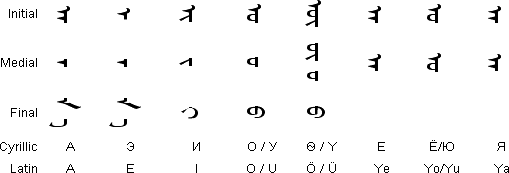
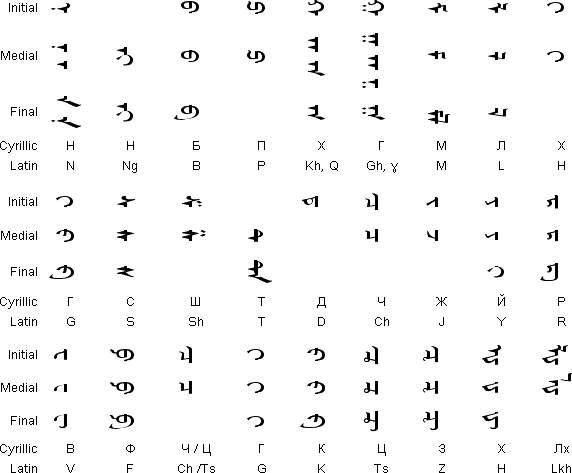
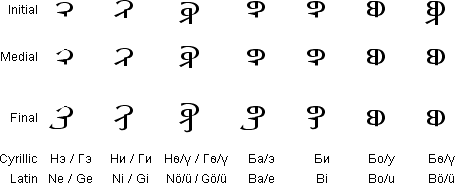
The first set of numbers (tegen, nigen, etc.) are classical Mongolian,
the others are modern Mongolian.
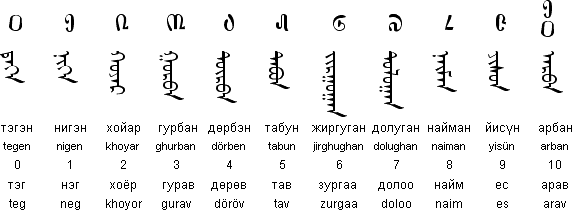
Hear a recording of the Mongolian numbers by Senji

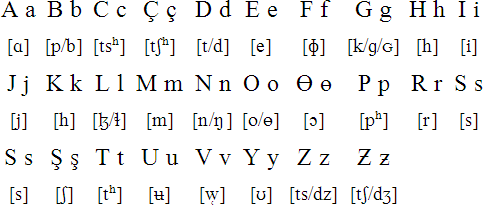
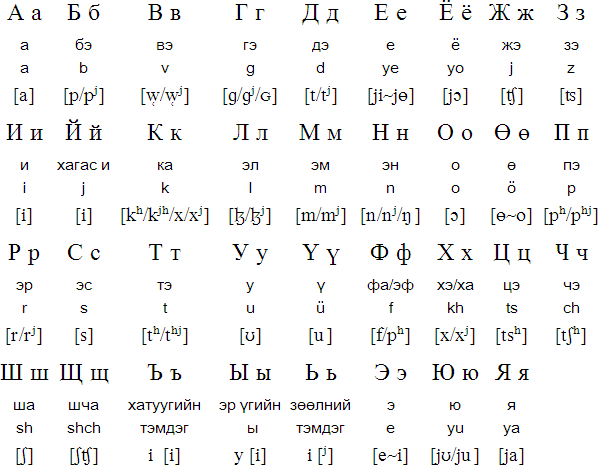
Hear a recording of the Mongolian alphabet by Senji
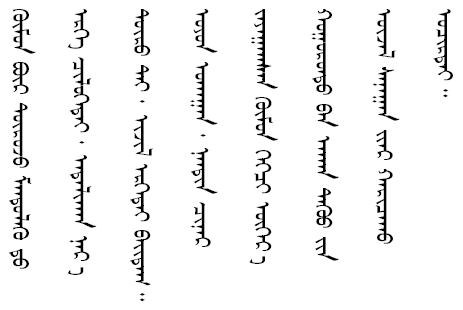
Хүн бүр төрж мэндлэхдээ эрх чөлөөтэй, адилхан нэр төртэй, ижил эрхтэй байдаг. Оюун ухаан нандин чанар заяасан хүн гэгч өөр хоорондоо ахан дүүгийн үзэл санаагаар харьцах учиртай.
Khün bür törzh mendlekhee erkh čölöötei, adilkhan ner törtei, izhil erkhtei baidag. Oyuun ukhaan nandin čanar zayaasan khün gegč öör khoorondoo akhan düügiin üzel sanaagaar khar'tsakh učirtai.
Hear a recording of this text by Bat-Orgil Myagmardorj
Hear a recording of this text by Nomun Myagmardorj
All human beings are born free and equal in dignity and rights. They are endowed with reason and conscience and should act towards one another in a spirit of brotherhood.
(Article 1 of the Universal Declaration of Human Rights)
Information about Mongolian | Soyombo Script | Mongolian Square Script | Galik Alphabet | Phrases | Numbers | Tower of Babel | Learning materials
Information about the Mongolian language and Mongolia
http://en.wikipedia.org/wiki/Mongolian_language
http://www.mongoluls.net
http://www.sytra.cn/mongolian-translations-service.html
http://www.cjvlang.com/Writing/writmongol/mongolalpha.html
http://silverhorde.viahistoria.com/main.html
http://www.linguamongolia.co.uk
Traditional Mongolian fonts
http://www.wazu.jp/gallery/Fonts_Mongolian.html
http://www.mongoluls.net/font.shtml
http://www.mongolfont.com/en/index.html
Online Mongolian lessons
http://mongoluls.net/mongolianlanguage/
Learn Mongolian with Glossika
Learn Monoglian with Ling
Online Mongolian dictionaries
http://www.bolor-toli.com
http://www.linguamongolia.co.uk/searchdict.html
http://asuult.net/dic/
Mongolian-English Dictionary - commercial dictionary software for Uighur-script Mongolian
http://www.linguamongolia.co.uk/soft1.html
Mongolian phrases
http://mongoluls.net/mongolianlanguage/
http://www.viahistoria.com/SilverHorde/phrases.html
http://wikitravel.org/en/Mongolian_phrasebook
http://www.byki.com/category/Mongolian/a/
http://www.youtube.com/watch?v=ofPsOPFUlv4
Online Mongolian news
http://www.mongolnews.mn
Online Mongolian radio
http://www.mnb.mn
http://www.mglradio.com
Mongolian chat room
http://www.boljoo.com
Online Mongolian Bible in the Classical Mongolian Script
http://www.mongolbible.com
MongoliaOnline - Your guide to Mongolia - in English and Mongolian (Cyrillic)
http://www.mol.mn
Alasha, Barin, Buryat, Chakhar, Daur, Jarud, Kalmyk, Khamnigan Mongol, Khorchin, Mogholi, Mongolian, Monguor, Santa / Dongxiang
Alasha, Barin, Buryat, Chakhar, Evenki, Jarud, Khamnigan Mongol, Khorchin, Mongolian
Abaza, Abkhaz, Adyghe, Aghul, Akhvakh, Akkala Sámi, Aleut, Altay, Alyutor, Andi, Archi, Assyrian / Neo-Assyrian, Avar, Azeri, Bagvalal, Balkar, Bashkir, Belarusian, Bezhta, Bosnian, Botlikh, Budukh, Bulgarian, Buryat, Chamalal, Chechen, Chelkan, Chukchi, Chulym, Chuvash, Crimean Tatar, Dargwa, Daur, Dolgan, Dungan, Enets, Erzya, Even, Evenki, Gagauz, Godoberi, Hinukh, Hunzib, Ingush, Interslavic, Itelmen, Juhuri, Kabardian, Kaitag, Kalderash Romani, Kalmyk, Karaim, Karakalpak, Karata, Karelian, Kazakh, Ket, Khakas, Khanty, Khinalug, Khorasani Turkic, Khwarshi, Kildin Sámi, Kili, Komi, Koryak, Krymchak, Kryts, Kubachi, Kumandy, Kumyk, Kurdish, Kyrgyz, Lak, Lezgi, Lingua Franca Nova, Lithuanian, Ludic, Macedonian, Mansi, Mari, Moksha, Moldovan, Mongolian, Montenegrin, Nanai, Negidal, Nenets, Nganasan, Nivkh, Nogai, Old Church Slavonic, Oroch, Orok, Ossetian, Pontic Greek, Romanian, Rushani, Russian, Rusyn, Rutul, Selkup, Serbian, Shor, Shughni, Siberian Tatar, Sirenik, Slovio, Soyot, Tabassaran, Tajik, Talysh, Tat, Tatar, Teleut, Ter Sámi, Tindi, Tofa, Tsakhur, Tsez, Turkmen, Tuvan, Ubykh, Udege, Udi, Udmurt, Ukrainian, Ulch, Urum, Uyghur, Uzbek, Veps, Votic, Wakhi, West Polesian, Xibe, Yaghnobi, Yakut, Yazghulami, Yukaghir (Northern / Tundra), Yukaghir (Southern / Kolyma), Yupik (Central Siberian)
Languages written with the Latin alphabet
A-chik Tokbirim, Adinkra, ADLaM, Armenian, Avestan, Avoiuli, Bactrian, Bassa (Vah), Beitha Kukju, Beria (Zaghawa), Borama / Gadabuursi, Carian, Carpathian Basin Rovas, Chinuk pipa, Chisoi, Coorgi-Cox, Coptic, Cyrillic, Dalecarlian runes, Elbasan, Etruscan, Faliscan, Fox, Galik, Georgian (Asomtavruli), Georgian (Nuskhuri), Georgian (Mkhedruli), Glagolitic, Global Alphabet, Gothic, Greek, Hurûf-ı munfasıla, Irish (Uncial), Kaddare, Kayah Li, Khatt-i-Badí’, Khazarian Rovas, Koch, Korean, Latin, Lepontic, Luo Lakeside Script, Lycian, Lydian, Manchu, Mandaic, Mandombe, Marsiliana, Medefaidrin, Messapic, Mongolian, Mro, Mundari Bani, Nag Chiki, Naasioi Otomaung, N'Ko, North Picene, Novo Tupi, Nyiakeng Puachue Hmong, Odùduwà, Ogham, Old Church Slavonic, Oirat Clear Script, Ol Chiki (Ol Cemet' / Santali), Old Italic, Old Nubian, Old Permic, Ol Onal, Orkhon, Osage, Oscan, Osmanya (Somali), Pau Cin Hau, Phrygian, Pollard script, Runic, Székely-Hungarian Rovás (Hungarian Runes), South Picene, Sutton SignWriting, Sunuwar, Tai Viet, Tangsa, Todhri, Toto, Umbrian, (Old) Uyghur, Wancho, Yezidi, Zoulai
Page last modified: 14.04.24
[top]
You can support this site by Buying Me A Coffee, and if you like what you see on this page, you can use the buttons below to share it with people you know.

If you like this site and find it useful, you can support it by making a donation via PayPal or Patreon, or by contributing in other ways. Omniglot is how I make my living.
Note: all links on this site to Amazon.com, Amazon.co.uk
and Amazon.fr
are affiliate links. This means I earn a commission if you click on any of them and buy something. So by clicking on these links you can help to support this site.
[top]